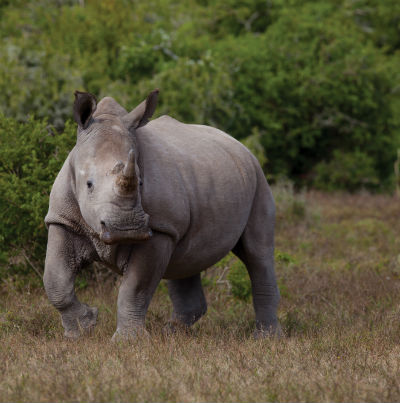Conservation optimism
CONSERVATION OPTIMISM
Successes are possible in conservation. They’re hard won, but they give us hope and they open our eyes to a more optimistic future, says Born Free’s Conservation Projects Officer Penny Banham
Sitting outside my tent in a private game reserve in South Africa, huddled under a blanket and ankle throbbing from a recent fall down an aardvark hole, I watched the rhino graze on the plain in front of me, her calf running back and forth, squeaking with excitement, joyous and free in the evening sun.
Susan, the southern white rhino, was one of 60 rhinos I was monitoring, tracking their movements and recording their behaviour.
Thought to be extinct at the end of the 19th century, with a population of just 100, the southern white rhino has been brought back from the brink of extinction by determined conservationists.
Today, over 20,000 southern white rhinos exist. Despite the current poaching crisis of rhinos for their horn, this species is actually a conservation success story.
Successes are possible in conservation. They’re hard won, but they give us hope and they open our eyes to a more optimistic future.

Why is conservation optimism needed?
In the face of species decline, rampant habitat loss and failed conservation initiatives, the world of conservation can seem very bleak. Conservation has been described as a crisis discipline. Conservationists, try as they might, tend to be the bearers of bad news, horrifying people with statistics of deforestation rates, shocking them with tales of poaching and outlining the future of the world without the elephant, lion or tiger. Except, this constant message of doom and gloom, as it turns out, could be habitualising people to the worrisome state of affairs, or, even worse, creating a culture of denial, paralysis, apathy and helplessness. It’s time to engender an optimistic, hopeful culture in conservation.
What is conservation optimism?
Conservation optimism is a movement of scientists, conservationists and practitioners who are determined to share stories of optimism and success in conservation, showing that our actions make a difference. For example, giant panda numbers have increased and the species has moved from endangered to vulnerable; the Ethiopian wolf, Africa’s most endangered carnivore, is recovering from a recent rabies outbreak and has seen a 30% increase in population numbers since 2016; and conservation initiatives have improved the status of the American bison, numbering just 750 in the 19th century to over 350,000 now. These achievements are remarkable and are growing every day.
Conservation optimism is not sugar coating issues or living in blissful ignorance. Neither is it poorly placed confidence in new “gee-whiz” technology, stoic resignation’ or the blatant cover up of our failures. It’s the recognition that we have the ability to change dire and worrying circumstances. It’s about celebrating success at all levels and most importantly, learning from our failures.
Conservationists are typically focused on challenges, problems, what is not working, and trying to make it work. We forget to acknowledge to ourselves the projects that have worked. We forget to acknowledge hope. Hope is powerful. As renowned environmentalist David Orr says: “hope is a verb with its sleeves rolled up..hopeful people are actively engaged in defying or changing the odds”.
Here at Born Free, we know that success is possible.
Predation of livestock is common where human populations encroach on wildlife habitats, with costs to both residents and wild animals. Since 2010, Born Free, through its Pride of Amboseli programme, has been working to address the issue of predator conflict in the Amboseli ecosystem by working with community members to build predator proof bomas (enclosures) to corral livestock at night and protect them from predators. To the Maasai, in East Africa, livestock is key to their lives; it can be their only source of livelihood and is tied to cultural perceptions of wealth. In the Amboseli ecosystem in Kenya, at least 63 lions were killed in retaliation after livestock depredation events between 2003 and 2008. With a population of only around 100 lions, this was not good news.
Communities contribute towards the cost of the materials needed for strengthening their bomas while also providing labour to help with construction. The bomas are so effective that no livestock or lions have been killed or injured from the 239 predator proof bomas built so far. Our programme has enabled at least 66,000 livestock belonging to about 5,000 community members to be better protected. The impacts are felt at a local level – to each and every person involved in the project, their livestock, their income and their future are secured – but also at a macro-level.
Right across the Amboseli ecosystem, the collective impact of lion interventions by Born Free and its partners has seen a significant increase in lions. Currently, the population is thought to be at about 200 individuals and at carrying capacity.
Despite grave issues in conservation, it is possible to have hope, but it must be hope that engenders action. Let’s roll up our sleeves, strap on our boots and pull up our socks because there is work to do.
